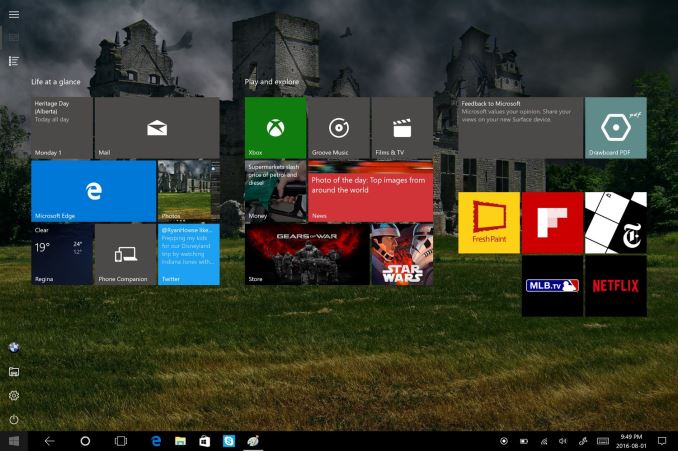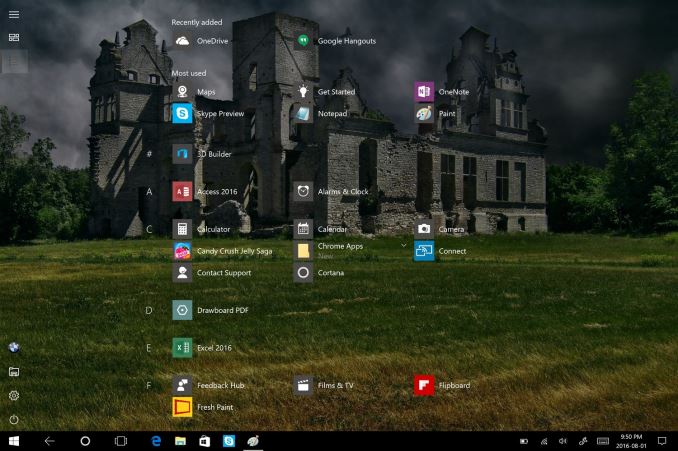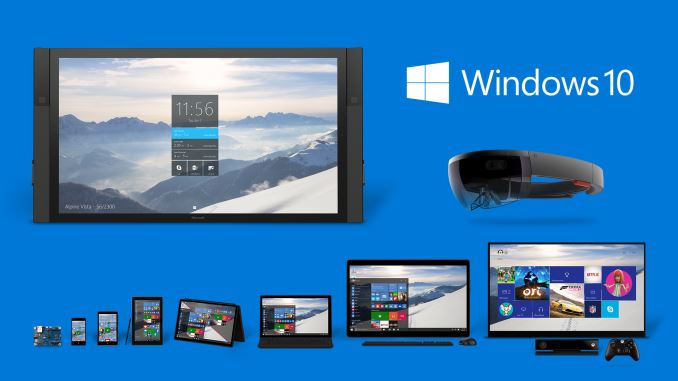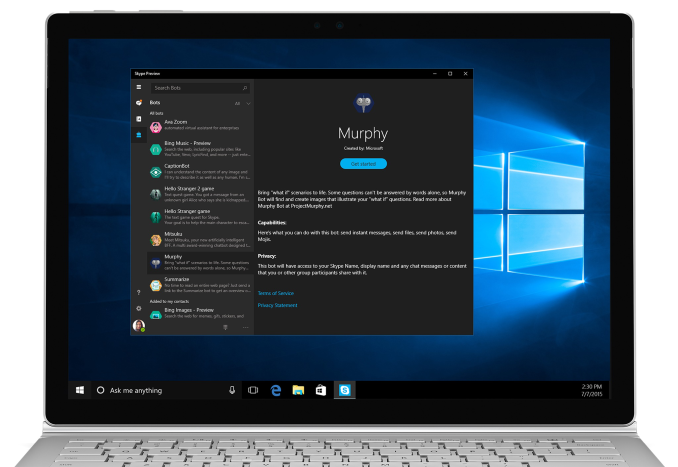Windows 10 Anniversary Update: The Road To Redstone
by Brett Howse on August 2, 2016 8:00 AM EST- Posted in
- Operating Systems
- Microsoft
- Windows 10
Tablet Mode changes, Windows Everywhere, and Skype
Tablet Mode
When Windows 10 launched, Tablet Mode, aka Continuum, was the new solution to offer Windows 10 across both traditional desktop computers, as well as touch first, or touch only devices like tablets. Overall, the interface worked well enough, but it was a step back from the usability of Windows 8.1 as a tablet interface. Still, the balance of desktop versus tablet was improved greatly with Windows 10, so it was a net win. With the Anniversary Update, Microsoft is bringing some of the Windows 8.1 features back to improve Tablet Mode.
The first change is the Start Screen layout. It’s still the same basic design, but the left hand side has been adjusted to make it more usable. The hamburger menu stays at the top, but directly under it is now the All Apps button. Toggling this switches from the Start Screen to All Apps much more akin to how it was in Windows 8.1, with a full screen scrollable list, rather than just a list on the left side. It makes it a lot easier to scroll more apps quicker, and see everything you have installed. Also, the left side contains icons for File Explorer, Settings, Power, and logout. It’s a subtle change, but it really is a lot more usable now.
Another thing that was missing was the full-screen tablet experience: in Windows 8.1, full-screen apps would lose the taskbar at the bottom. When Windows 10 shipped, the taskbar would stay planted at the bottom. There’s now an option to auto-hide the taskbar to make it a more immersive feel. I personally really liked the taskbar, since it makes it much easier to switch apps, but it’s nice to have the option back for those that prefer it.
The browser is a big part of tablets, and this has already been mentioned, but the addition of swipe navigation in Edge helps a lot as well.
Tablet Mode has improved a lot since the initial release, and these changes, added to previous changes such as the ability to toggle on “more tiles” makes the latest update much better to use. It’s likely still not quite as good as Windows 8.1 was, but the net gain with the much better desktop is still a better overall solution.
Windows Everywhere
It’s been Microsoft’s goal for a long time to bring Windows 10 to all devices, and that was a tall hill to climb. But, it has happened, and users of Windows can now experience the benefits of the work to get here. Windows 10 Mobile is not a different operating system, but the same Windows 10 base with a different UI to make it work better on the small touch screen. With Microsoft’s failure to establish a foothold in the mobile market, it’s almost too little, too late, but regardless, fixes and changes they make to Windows 10 also find their way to the phone. This is as simple as the new mail app, updated to support multiple sending accounts, instantly worked on the phone too since it’s a Universal Windows App. What’s more, Windows has been expanded to work on devices as small as IoT, to Hololens, to the ultra-large screen of the Surface Hub.
This work has also expanded to the Xbox One, and with the Summer Update for Xbox rolling out on July 29th, the fruits of this labor has already been seen. The latest Xbox update offers much of the same interfaces as Windows 10, including slide-out menus with a hamburger button, as well as the ability to (finally) run Universal Windows Apps. The Movies and TV app on the Xbox is the exact same one as on the PC, which is the exact same one as on the phone. Updates to the UWP will fix issues on all three.
It’s been a long road, and the casualty of the march to where Microsoft made it is the loss of the mobile market. They’ve transitioned there to providing apps and services, but Windows 10 Mobile is now pretty good at a time where it’s unlikely most people will ever use it.
Skype
And how can we forget Skype? Skype’s had a long and arduous road to where it is now, but it seems like it’s finally become a focus of the company. With the Anniversary Update, we see our first look at the new UWP version of Skype, replacing the old WinRT version, and likely eventually the Win32 version as well. It’s been out in preview for a while, and overall it’s been pretty solid.
It offers a dark mode, much like many of the Microsoft UWP apps, and the same UWP exists on Windows 10 Mobile as well. Likely the biggest feature is one that hasn’t made it to Skype yet. Microsoft has promised to add SMS support within Skype, so you can use Skype as a portal for both Skype messages and SMS. It’s something that they already had in Windows 10 Mobile when it first shipped, but it was later removed, and then a new Messaging app was tested, which was also killed off. The final solution is to use the Skype UWP to allow you to send SMS messages from your PC, and assuming it’s not too far out, that’s a decent solution considering how much better the Skype UWP has been.














194 Comments
View All Comments
BrokenCrayons - Tuesday, August 2, 2016 - link
Microsoft has painstakingly monitored the OS usage of its users for a year now. Based on highly granular and detailed data they've collected, they build the best possible mix of software tailored to what they know best as the needs of the end user. Although you're getting things you think you don't need and feel like are being forced upon you, it's clear that eventually you'll realize your error and start using the things the company has decided are necessary.CountDown_0 - Tuesday, August 2, 2016 - link
Spoken like a true brain-washed Microsoft fanboy, especially the last sentence. Congratulations!Michael Bay - Tuesday, August 2, 2016 - link
I bet you see MS zombies under your bed!smilingcrow - Tuesday, August 2, 2016 - link
If MS wanted me to see zombies under the bed I'm sure they could arrange it!Updated on Thursday and had some minor issues but it feels like one step forward and one step back.
What is partly making me seriously consider rolling back to 8.1 is the fact they are removing features from the Pro version with this update.
I suspected this might happen as you are buying into an open ended platform rather than a more static OS.
If I still trusted MS to be competent and to do the right thing I'd stick with them but I don't trust them to do either.
Maybe it's time to look at Linux and even a Hackintosh as I feel this chapter is closing.
I still remember when I first installed NT 3.51 and was blown away.
Many good years after with NT4, Win2K and then a slow decline since they stopped making a workstation OS and it was tainted by the merger with the consumer OS's needs.
Mr Perfect - Tuesday, August 2, 2016 - link
That was clearly sarcasm on BrokenCrayon's part.MrSpadge - Tuesday, August 2, 2016 - link
Dude, switch your irony & sarcasm detector on!fanofanand - Tuesday, August 2, 2016 - link
Just because a statement doesn't have /s behind it doesn't mean it isn't sarcasm.....K_Space - Tuesday, August 2, 2016 - link
Surely you can't be serious? I mean I know nerds are not known for recognising sarcasm but common!On a separate note, in reply to an earlier comment: all of my opt out choices (that would pretty much be all of them), have been preserved. No reset.
Cortana and voice recognition: I'm hoping we won't end up with a similar fiasco to the early Samsung smart TVs capturing voice data randomly and without permission for optimisation and analysis.
Ascaris - Wednesday, August 3, 2016 - link
Common? What's common? That nerds don't get sarcasm? Only Sheldon seems to have that problem...vanilla_gorilla - Tuesday, August 2, 2016 - link
I can't tell if this is sarcasm or not. That's terrifying.